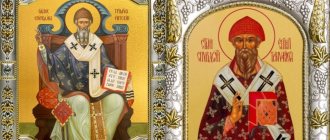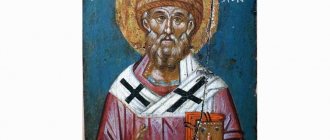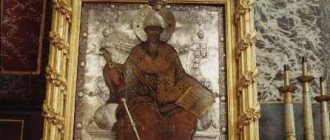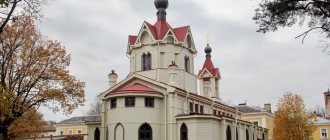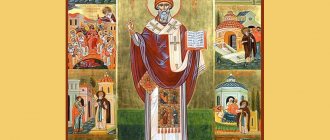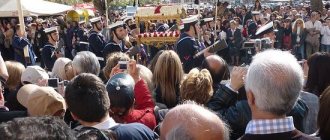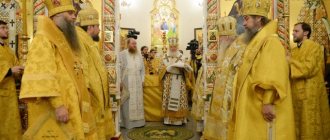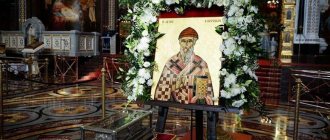Once at a meal, our (now ever-remembered) wise abbot, Father George, said: “Whoever prays to Saint Spyridon of Trimythous will never be in need. Pray to him and you will not be left without a piece of bread.” And he began to tell the life of the saint.
We froze, and the light of the bright Mediterranean sun spread before our eyes, the red tiled roofs sparkled over the white sandstone walls, the branches of old olive trees swayed, a sea wave crashed near the coastal rocks, showering with water dust, and the serene blue of the sky covered everything from above. God-blessed land, warm sea, sun, silence of the night with the ringing of cicadas, close stars.
Not just a piece of bread, but with the grace of God, St. Spyridon generously fed us in Corfu. After Father George’s story about him, we immediately got ready and, with blessings, flew to Greece, to Kerkyra on the island of Corfu.
The joy of this meeting still warms my heart, even though many years have passed. Father George taught us to be friends with the saints, to know them, to love them, to talk, to call for help. Since then, Saint Spyridon of Trimifuntsky has become close and dear. And you don’t just run to him for a piece of bread, although he is a quick helper in everyday affairs, but for spiritual consolation and support. Especially now that Father George is no longer around.
Icon 1514 Church of the Archangel Michael and the Mother of God in the village of Galata, Cyprus
Life of a Saint
Saint Spyridon (years of life 270-348) was an ordinary villager, like all his compatriots - Cypriots (the saint was originally from Cyprus). But his difference from all other shepherds and farmers was that Spyridon had true faith in God and boundless love for Him.
This love and faith created a saint and friend of God from an ordinary shepherd, as it is said:
“Whoever loves Me will keep My word, and My Father will love him, and We will come to him and make our home with him” (John 14:23), “On that day you will know that I am in My Father, and you in Me, and I in you” (John 14:20), and “if you ask anything in My name, I will do it” (John 14:14).
Saint Spyridon lived for God, prayed with the Angels, and many miracles were performed through his prayers. He also always stood up for the offended and helped those in need, acting according to the word from the Lord:
“Give to the hungry of your bread and to the naked of your clothing; of whatever you have in abundance, give alms, and let not your eye spare when you give alms” (Tob. 4:16).
For faith and mercy, jealousy for “Abraham’s strange-loving disposition,” the Lord blessed Spyridon with the gift of miracles - he healed the sick and demon-possessed, as it is said:
“in my name demons will be destroyed” (Mark 16:17).
The people respected this heavenly man - an earthly Angel, and when he was widowed, the townspeople handed him a pastoral staff, placing him at the head of the church of the city of Trimifunt for episcopal service.
Trimifunt (now Tremefusya, Turkish territory) is a city on the island of Cyprus, located approximately 25 km from the center of Nicosia.
Should relics be incorruptible?
The incorruption of relics is not a prerequisite for the canonization of an ascetic. The main thing is the fact of the presence of miraculous help through prayers to him. The preservation of the relics incorruptible in Christianity is perceived as a miracle, contributing to the rapid spread of veneration of the saint. However, the relics of saints do not perform miracles on their own.
“Our Savior Christ gave us saving springs, the remains of saints, pouring out benefits in various ways on the worthy. And this is through Christ, Who dwells in them” (decision of the Seventh Ecumenical Council).
However, relics are not a magical amulet. Touching the relics in itself is not miraculous. The main and obligatory condition for this is faith in the holiness of the ascetic and in the mercy of God.
“In Orthodox Christianity, God alone is the Giver of all blessings. He is the Source, and His saints are just wires. He is the Sun, and His saints are only mirrors reflecting His light. And if a person approaches a shrine with relics and makes a wish or believes that kissing it will solve all his problems, this is paganism and idolatry” (priest Svyatoslav Shevchenko).
Miracles during and after life
Among the episodes in the life of the saint, which clearly signify miraculous faith and special chosenness, there is a story about his victory in a dispute with an Aryan philosopher at the First Ecumenical Council in Nicaea in 325.
Then, among the 318 members of the Council, wise men and righteous men who debated in defense of the Orthodox faith against the teachings of the wicked Arius, there was one simpleton - the former shepherd Spyridon, who, without words, with the help of God's inspiration, simply and clearly smashed the arguments of the Gnostic sophisticated mind that limited the existence of the Son God's
Because “the preaching of Christ is not in the words of human wisdom, but in the manifestation of the Spirit and power.”
Spyridon showed the Trinity of God - the Father, the Son and the Holy Spirit - the Consubstantial and Indivisible Trinity, taking a brick in his hands, squeezing it - water flowed down, fire rushed up, clay became in his hand.
“You seemed to be wise of God and, having squeezed the clay in your hands, you clearly understood the trinity of Persons to everyone,” the Church sings about him.
The demonic force was afraid of Spyridon’s holiness, struck down by God’s grace, pagan idols fell from his approach. Through his life-giving prayer, vessels were filled to the brim with oil, the flow of rivers stopped their flow, destructive droughts were revived by rain, the dead rose, returning to life.
He was a seer and saw through the human soul, healed secret sins, and brought deceivers to repentance.
Spyridon is a healer of the passions of love of money and covetousness. Thus, he healed a merchant who wanted to deceive him to keep the gold he had borrowed.
Spiridon always allowed the person asking for a loan to take what he needed from the pantry. The borrower exclaimed: “Won’t you come and see, what if I take away more than I ask?” Spiridon replied: “You will not take away more than you need, but you will return as much as you can.”
The deceiving merchant, having used the debt and brought it back for repayment, went to the storeroom, but only out of greed kept it and did not invest it back. And from this excess he soon went bankrupt. Having lost everything, in need the deceiver again came to ask for help from the saint.
In response to the merchant’s request for money, Spiridon, smiling through his gray mustache, sent him to take as much as he needed from the treasury. But there was nothing to take there. The covetous man had to ask for forgiveness from Spiridon and repent before God. Only by repenting and asking for the saint’s prayers was he able to change his situation.
Interesting fact
Returning from the Council of Nicaea, Spiridon found his daughter Irina dead. The father grieved and prayed. One day a woman came to him and said that she had given Irina some gold jewelry for safekeeping. Now she demanded the treasure back, but Spiridon did not know where his daughter hid the gold. Having searched everything and found nothing, but regretting the tears of the woman who had lost her wealth, Spiridon came to the tomb and turned to his daughter with prayer, saying: “My daughter, answer in the name of Jesus Christ where the treasure is.” Through his prayer, awakening from eternal sleep, Irina opened her eyes and named the place. After listening, the father said to his daughter: “Now, my child, rest in peace until Christ resurrects you after the Second Coming.” This was in front of the shocked woman who came with the saint to the tomb - what is today’s concern for earthly wealth worth before the coming eternity.
Miracles continued even after the repose of Saint Spyridon of Trimythous. When the grave was opened many years after his death, they found incorruptible relics with soft skin and recognizable facial features. In the 7th century, the relics of the saint were transferred from Cyprus by order of Emperor Justinian II (685-695) from the danger of capture and desecration to the capital of Byzantium and remained there until the mid-15th century.
After the fall of the empire, the shrine was transported from Constantinople first to Serbia and then to Corfu. In 1589, a temple was consecrated in Kerkyra in honor of St. Spyridon, where he still resides in his venerable body. Local residents consider him their patron and master of the island.
Interesting fact
It is interesting that the saint’s body has the usual temperature of 36.6 and the weight of an adult man, and his hair and nails grow like a living person, and most importantly, his clothes and shoes wear out. Every six months Saint Spyridon is rerobed and re-shoeed. Again and again, the nuns sew shoes for the toiling shepherd, who does not leave the care of his sheep even after death.
In Kerkyra they say how one fisherman often laughed at the faith of his fellow countrymen in the miracles of Spyridon, although he himself bore the name Spiro (Spiridon). But one day he got caught in a storm and fell overboard, drowning. He was drowning, but suddenly he found himself on the shore. Having come to his senses and remembering how he shouted the last prayer, and the hand pulling him from the abyss, he ran to the temple to check his guess.
And in the church at that time the priest and deacon could not open the shrine of Spyridon. As soon as the fisherman ran in, the shrine opened and everyone saw that the slippers on the saint’s feet were wet, and sand and shells were stuck to the soles. Shocked, Spiro gave all his savings to make a precious lamp for the saint’s shrine in gratitude for his salvation.
The flow of pilgrims to the relics of the saint, including from Russia, keeps coming every year, and miracles multiply.
Old-timers tell how during the Second World War, when the island was bombed, everyone hid in the Church of St. Spyridon in the center of Kerkyra, because in a strange way, breaking the laws of physics, bombs from low-flying planes did not fall straight, but at an angle, and they were carried towards the sea never touched the church.
Prayer to Saint Spyridon of Trimifuntsky
Oh, all-blessed Saint Spyridon, great saint of Christ and glorious miracle worker!
Stand in Heaven before the Throne of God with the face of an Angel, look with your merciful eye at the people standing here and asking for your strong help. Pray to the compassion of God, the Lover of Mankind, not to judge us according to our iniquities, but to deal with us according to His mercy!
Ask us from Christ and our God for a peaceful and serene life, mental and physical health, earthly prosperity and all abundance and prosperity in everything, and may we not turn the good things given to us from the generous God into evil, but into His glory and the glorification of your intercession !
Deliver all who come to God through undoubted faith from all spiritual and physical troubles. from all yearnings and devilish slander! Be a comforter to the sad, a physician to the sick, a helper in times of adversity, a protector to the naked, a protector to widows, a protector to the orphans, a nourisher to the baby, a strengthener to the old, a guide to the wandering, a sailing helmsman, and intercede to all those who require your strong help, even useful for salvation!
For if we are guided and observed by your prayers, we will reach eternal rest and together with you we will glorify God, glorified in the Trinity of Saints, the Father and the Son and the Holy Spirit, now and ever and unto ages of ages. Amen.
Troparion
At the first council, you appeared as a champion and wonderworker, God-bearing Spyridon, Our Father. In the same way, you cried out to the dead in the tomb, and you turned the serpent into gold: and whenever you sang holy prayers, you had the most sacred angels serving you. Glory to him who gave you strength, glory to him who crowned you, glory to him who heals you all.
Kontakion
Having been wounded by the love of Christ, the most sacred one, having fixed your mind on the dawn of the Spirit, by your diligent vision you have found an act more pleasing to God, having become a divine altar, asking for divine radiance to all.
What did the old man look like?
By his appearance, you can unmistakably recognize Saint Spyridon on icons; you won’t confuse him with anyone. On icons he is depicted wearing a simple shepherd's hat, called a kidar, woven from palm branches. This simple shepherd's tiara became more glorious to him than all the well-decorated episcopal mitres.
The people in Trimifunt revered their shepherd, although he lived simply and was always seen dressed in the most modest clothes. In his hands he carried a palm staff, and on his neck a clay vessel, in which the holy oil from the Cross of the Lord was usually kept.
One day, this wretched outfit misled the arrogant courtier, who, seeing a poor wanderer entering the palace, hit the bishop in the face. And the saint, with humility, turned the other cheek to the angry one, according to the commandment. The taken aback nobleman only then, having regained his sight, saw who was standing in front of him.
Ashamed of the saint’s meekness and asking for forgiveness, he led Spyridon to the palace to the Emperor Constantius, who had long been suffering from an incurable illness.
The monarch had a dream in which an Angel named the name of a person whose prayer could heal this serious illness, and the whole court was waiting for Spiridon.
As soon as Constantius, standing up, bowed his head under the blessing of the Bishop of Trimifuntus, entering the throne room, and the hand of the saint touched the august head, the emperor was delivered from suffering, completely healed.
In gratitude for the miraculous help, the sovereign began to offer the bishop gold, but he refused, because he came to the palace for the glory of God, and not for a reward.
The emperor insisted, then Spyridon gave the sovereign and the entire court a pastoral lesson in selfless service to God and people: having accepted the gold and leaving the palace, he distributed everything to the poor.
“Gold, like feces, is imputed to you,” this lesson shocked rich Constantinople, and respect for the spirit-bearing father among the people increased, “more than gold, I shine with dispassion and have been enriched, reverend, by the gift of the Spirit to all the gold.”
Shocked by the saint’s dispassion and indifference to earthly wealth, the emperor himself distributed rich alms to the poor and from then on ordered the holy Church to be freed from taxes to the state treasury, for “it is indecent for the servants of the Immortal King to pay tribute to a mortal king.”
His life tells us about the life of Spiridon
Cyprus became the birthplace of not only the pagan Aphrodite, but also one of the most revered Christian saints.
We know about the life of Spyridon from his life. He was born in Cyprus, in a village called Askia. From early childhood he fell in love with a solitary life and spent his time with the sheep that he tended.
Askia
this is the name of the village in Cyprus where Spiridon was born
He married a pious virgin and she bore him a daughter. But marital happiness was short-lived - Spiridon’s wife died suddenly. But he did not fall into despair and sorrow, strengthening his spirit with prayer.
Saint Spyridon of Trimifuntsky was a shepherd and therefore is depicted in icons wearing a shepherd’s hat
History of the saint's shoes
In the shrine where the saint’s body is laid, he now rests dressed in expensive bishop’s vestments. Every six months the ritual of re-vetting the saint is performed. And this is not just a ceremony, but a necessity.
Saint Spyridon has to be changed because his vestments are deteriorating and his shoes are especially worn out. Because the saint of God travels all the time, going around those who call on him, giving his miraculous help to everyone who asks.
Two servants unlock the raku with two keys simultaneously. But, as they say, sometimes the cancer is not unlocked. They believe that the saint is not there at this time, he walks on the ground. We have to wait.
It has been documented that the shoes specially made for the saint’s feet - soft red velvet shoes, or as they sometimes say - slippers, over time have creases and scuffs. Therefore, the old pair is taken off and new shoes are put on.
After replacing the slippers with new ones, the worn-out shoes are cut into small pieces right in the temple and distributed to everyone. These tiny pieces of fabric, packed in small envelopes, and equipped with the blue seal of the Kerkyra Church, are called filahto - shrine.
And this is the most desired reward and blessing from the saint for every pilgrim.
Activities of the parish
The church runs a Sunday school for children who study the Law of God, the foundations of Christian morality and the Church Slavonic language. In addition to these lessons, children can enroll in singing, choreography, art, English, playing musical instruments, chess and handicraft clubs. The teachers at the school have specialized education, since it is important for church ministers to take care of the growing generation and their education.
All school participants take an active part in the activities of the temple: they play in Christmas and Easter productions, sing in the church choir, and go on pilgrimage trips.
Where is the piece of “filahto” located in Moscow?
Sometimes, with the blessing of the current bishop of Corfu, the shoes taken from the saint’s feet are placed in a reliquary and donated to other Orthodox churches. Spiridon's shoes have been known in Russian churches since the 18th century (more often, however, not the shoes themselves, but particles - filahto).
- A particle of the relics of Spiridon is in the temple built in honor of the Bishop of Trimifunt in Nagatinsky Zaton. Address: Moscow, Sudostroitelnaya str., 48A. Metro Technopark, Kozhukhovskaya, Pechatniki.
- In the church of St. Spiridon in Fili, on Barclay Street there is a boot. Address: Moscow, Barclay St., vl. 9 (metro station Bagrationovskaya).
- In the Church of the Resurrection of the Word on Uspensky Vrazhek there is a miraculous icon of the saint with a reliquary reliquary. An akathist is performed in front of the icon every week. Address: Moscow, Bryusov lane, 15/2. Metro Tverskaya, Okhotny Ryad, Chekhovskaya.
In the Danilov Monastery
The shoe of St. Spyridon in a special icon case was donated in 2007 by Metropolitan Nektarios of Kerkyra to the Danilov Monastery. The shrine with a particle of the relics of St. Spyridon of Trimifuntsky is kept here and now in the Intercession Church. Monastery address: Moscow, st. Danilovsky Val, 22. Metro Tulskaya, Shabolovskaya, Auto src=»https://pravoslavie.wiki/wp-content/uploads/2019/03/svt.-Spiridon-i-Vlasij.jpg» class=»aligncenter» width= "400″ height="559″[/img]
What do they pray for?
- Saint Spyridon of Trimythous is revered by the Orthodox Church as the merciful patron of the poor, homeless and sick.
- Believers consider the saint to be a helper in case of difficulties due to lack of money, lack of necessary funds to support a family, or loss of a job or source of income.
- It has been noticed that prayer to Spyridon helps those in need find housing, resolves all sorts of problems when buying or exchanging an apartment, plans for their housing are miraculously realized, even if there were no real opportunities to purchase it, for example, for young families.
- Business people who need investments for business development know about the help of the saint.
- However, help is given only to those who share, help people, run their own business, not forgetting that we all walk under God, and do not covet or rob the poor.
What does Saint Spyridon of Trimifuntsky help with?
Saint Spyridon, being an ordinary layman until adulthood, was well acquainted with various everyday and family concerns. Therefore, believers turn to the saint with their everyday needs as a saint who understands and is close to them. Through prayers to him, many receive resolution of housing and financial problems, and mutual understanding is established in the family. Often those who ask receive healing from illnesses.
However, we must not forget that the sent benefits are not given personally by Saint Spyridon of Trimythous at his own request. The Gracious Lord completely rules over the world, Who helps us through the prayers of the holy saints. In this case, such a heavenly petitioner and intercessor is St. Spyridon of Trimythous.
“The saints are our prayer books and patrons in heaven and therefore living and active members of the militant, earthly Church. Their grace-filled presence in the Church, externally manifested in their icons and relics, surrounds us as if with a prayer cloud of the glory of God. It does not separate us from Christ, but brings us closer to Him, unites us with Him. These are not mediators between God and people who would remove the One Mediator Christ. They are our companions in prayer, friends and helpers in our service to Christ and our communication with Him” (Priest Dionisy Svechnikov).
Day of Remembrance
Memorial Day of St. Spyridon of Trimifuntsky December 25 (December 12, Old Style).
In Corfu, celebrations in honor of Saint Spyridon take place several more times:
11
August
1716
The memory of deliverance from the Turkish invasion through the intercession of the saint is celebrated.
- Palm Sunday celebrates the deliverance of the inhabitants of Corfu from the bubonic plague in 1629-1630. Then they saw a wonderful light over the temple of Spyridon and the city was saved.
- On Holy Saturday, a litany with the relics of the saint (procession of the cross) is performed in memory of salvation from famine in the 16th century. The sailors of the ship that came to the island with bread then said that they were forced to change course by an old priest walking along the sea ahead and calling the ship to the island.
- On the first Sunday of November, a procession is made with the holy relics of St. Spyridon in gratitude for the second salvation of the inhabitants of Kerkyra from the plague epidemic in 1673.
Orthodox teaching on the relics of saints
The veneration of the relics (remains) of saints dates back to the first times of Christianity. This has been mentioned in written evidence since the 2nd century. Even then, the value of the remains of God's saints was placed by believers above all earthly riches and treasures. For example, in the District Epistle on the martyrdom of Polycarp of the Church of Smyrna (Asia Minor), the bones of this saint are called “more precious than gold and expensive stones.”
“Just as the imperial crown, decorated on all sides with precious stones, gives off a varied shine, so the bodies of the holy martyrs, speckled as if with precious stones, with wounds raised for the Lord, are more precious and more venerable than any imperial crown” (St. John Chrysostom, 347-407) .
The dogma of the veneration of the relics of saints was finally formed at the Seventh Ecumenical Council (787, Nicaea). During earthly life, the bodies of God’s saints are a dwelling, a temple of the Holy Spirit. Therefore, even after separation from the soul, the body (that is, the power) is not deprived of heavenly grace, pouring it out abundantly on believers. Not only undecayed bodies and bone remains are recognized as holy relics, but even dust and ashes.
For example, Blessed Jerome of Stridon (342-430) mentioned this in his writings. Christians revered both the relics of the prophet Samuel, which existed in the form of dust, and the relics of the apostles Peter and Paul, which were preserved in the form of bones.
